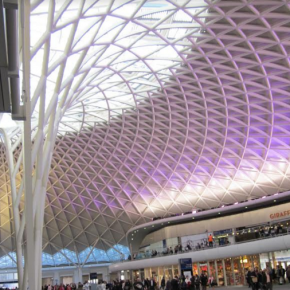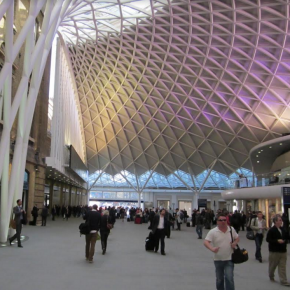
How the King’s Cross disaster changed fire safety regulations
Thirty years on from the King’s Cross disaster, Wrightstyle’s managing director, Tim Kemppster, remembers the tragedy and the redevelopment of the station.
The King’s Cross fire that claimed the lives of 31 people lead to better fire safety regulation and helped companies like Wrightstyle gain a better understanding of an unknown dynamic in how a small fire can become a conflagration.
Started most probably by a discarded match, despite smoking having been banned in the Underground two years earlier, the source of the fire was a partially wooden escalator shaft. In addition, the running track of the escalator had not been cleaned since the 1940s and was covered in grease and filled with rubbish.
With a lack of visible flames, the firemen first on the scene believed that it posed little threat, however, the fire rapidly grew, appearing to flash over and fill the ticket hall with flames and smoke. It was later revealed that a combination of wind movements caused by underground trains arriving and leaving created a 12mph wind, pushing air from the tunnels upwards and adding to the speed of the fire spreading.
 Brand new computer modelling and fire stimulation promoted a new theory of fire development within inclined shafts.The theory is called the trench effect, and involved hot gases in the buoyant plume to lie along the escalator surface, creating a rapid airflow that caused the gases to move up the escalator, increasing in proportion to the size of the fire, and eventually creating an effect much like a flamethrower, sending flames shooting upwards into the ticket hall.
Brand new computer modelling and fire stimulation promoted a new theory of fire development within inclined shafts.The theory is called the trench effect, and involved hot gases in the buoyant plume to lie along the escalator surface, creating a rapid airflow that caused the gases to move up the escalator, increasing in proportion to the size of the fire, and eventually creating an effect much like a flamethrower, sending flames shooting upwards into the ticket hall.
The computer modelling of the “fluid flow” of the fire helped to substantially advance the science of fire dynamics, using computational stimulation to look at how fires behave, with an emphasis on smoke and heat movement from their source.
Consequently, all wooden escalators were replaced, automatic sprinklers were installed and heat detectors in escalators, and all station staff are now required to take part in fire safety training twice a year.
Computer modelling has helped inform fire training since and influenced how Wrightstyle mitigates against threats caused by fire.
In supplying glazed components to the frontage of the new King’s Cross, as well as a safe evacuation route from the main administrative areas, we have brought a wealth of experience and expertise from other UK transport infrastructure projects, as well as overseas contract in Hong Kong and Dubai. Our advice to specifiers, based on extensive fire and bomb testing, is simple: always specify the glass and steel components as one integrated and tested assembly.
King’s Cross has had to learn painful lessons from its past, to build a facility offering the safety possible transit for its millions of customers every year. The lessons learned have also been applied in cities across the world.
Wrightstyle,
Unit 2&7 Banda Trading Estate,
Nursteed Road,
Devizes,
United Kingdom,
SN10 3DY
Visit Supplier's page
Latest news

28th March 2025
Ideal Heating Commercial announces 10-year warranty on Evomax 2 boiler
Evomax 2, the UK’s number one selling commercial wall-mounted boiler from Ideal Heating Commercial, is now available with a 10-year warranty.
Posted in Articles, Building Industry News, Building Products & Structures, Building Regulations & Accreditations, Building Services, Facility Management & Building Services, Heating Systems, Controls and Management, Heating, Ventilation and Air Conditioning - HVAC, Innovations & New Products, Pipes, Pipes & Fittings, Plumbing, Retrofit & Renovation, Sustainability & Energy Efficiency, Videos
28th March 2025
FLIR Si1-LD Acoustic Imaging Camera for Compressed Air Leak Detection
FLIR, a Teledyne Technologies company, introduces the Si1-LD, an industrial acoustic imaging camera that brings faster and more accurate compressed air leak detection to those operating on a modest condition monitoring budget.
Posted in Acoustics, Noise & Vibration Control, Articles, Building Industry News, Building Products & Structures, Building Services, Facility Management & Building Services, Information Technology, Innovations & New Products, Retrofit & Renovation, Sustainability & Energy Efficiency, Thermal Imaging and Monitors
28th March 2025
LIFTEX 2025 Seminar programme announced
Registration has opened for LIFTEX 2025. Now in its 37th year, LIFTEX 2025 is the UK’s only dedicated exhibition for the lift, escalator and access industry and takes place only once every three years.
Posted in Access Control & Door Entry Systems, Accessibility, Articles, Building Industry Events, Building Industry News, Building Products & Structures, Building Regulations & Accreditations, Building Services, Exhibitions and Conferences, Facility Management & Building Services, Health & Safety, Retrofit & Renovation, Security and Fire Protection, Seminars
28th March 2025
MCRMA welcomes ArcelorMittal UK to membership
A UK division of the global steelmaking business ArcelorMittal has become the latest new member of the MCRMA, the industry association representing the metal building envelope sector.
Posted in Articles, Building Associations & Institutes, Building Industry News, Building Products & Structures, Building Systems, Cladding, Facades, Posts, Restoration & Refurbishment, Retrofit & Renovation, Roofs, Steel and Structural Frames, Walls
 Sign up:
Sign up: